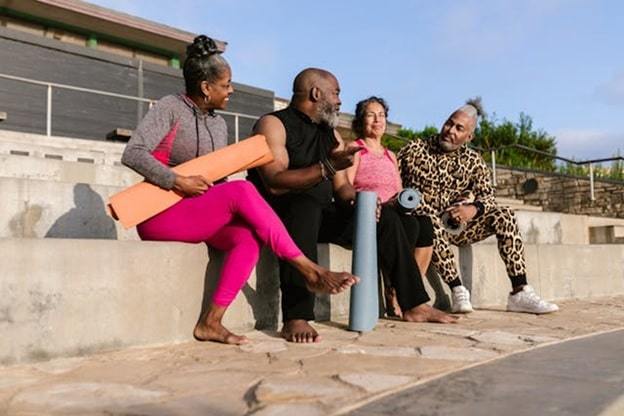Featured Image Caption: Group of Seniors Relaxing with Yoga Mats Outdoors
Jump to read...
Moving into an age-friendly neighborhood is not just an address change but often a step to a lighter life, better health, as well as a more conducive environment. The design features that make neighborhoods age-friendly, in particular, may be described as thoughtful and capable of enhancing the quality of life in addition to helping the resident feel secure and involved.
Less Maintenance, Simple Living
The freedom to go away with home repairs is one of the most obvious benefits of downsizing. The straining maintenance usually accompanies mansions, whether it is the maintenance of the lawn or repairing all the time. In an age-friendly community, the housing is set in such a way that these responsibilities are minimized. Housing in the form of smaller homes, townhouses, or condos takes much less physical effort, which leaves time and energy free. The change enables the residents to engage in things that give them pleasure but not property maintenance duties.
Less Toxic and More Available Design
Age-friendly planning is primarily concerned with safety and accessibility. Characteristics of homes and common areas in such neighborhoods tend to be wider hallways, floor plans based on single levels, as well as step-free access. The designs not only help to ease life in day-to-day activities but also lower the chances of falling or accidents, and this is one of the points of concern as individuals grow older. In addition to the households, the community as a whole is also designed in terms of safe streets and proximity to the necessary amenities. These facts generate a feeling of trust, having the knowledge that mobility issues are expected and expected to be accommodated.
Social Connection Opportunities
Bonds are further reinforced through such organized activities as fitness classes or cultural events. This sense of community fosters the establishment of new friendships and combating isolation, which is closely related to the enhancement of mental and emotional welfare. The close presence of individuals in a life stage similarity can also provide a friendly environment where there is easy exchange of experiences and advice.
Availability of Health and Wellness Resources
The other significant benefit is that of having health-oriented facilities. Wellness centers, fitness rooms, and walking paths are incorporated in many age-friendly communities in order to promote active lifestyles. To the more specialized customers, a move to an active adult community in Charlotte, NC, such as that, perhaps, would offer both convenient access to services and support of like-minded neighbors. With such resources, it is less demanding to have independence and prioritize health.
Monetary Gains and Freedom
Relocation to a neighborhood that is age-friendly can easily lead to significant economic gains. A smaller house is usually cheaper to buy or rent, and utility bills and maintenance costs are usually lower. Such a decrease in monthly expenditures will allow spending money on traveling, leisure, or medical expenses. Also, the sale of a bigger family home can offer a financial buffer or the ability to spend money on experiences instead of things. This is a combination of financial relief and flexibility, and one of the most feasible but effective elements of the transition.
A Lifestyle of Convenience
The design of age-friendly communities incorporates convenience. A lot of them can be found around shopping malls, restaurants, and cultural trips, and there is no need to drive long distances. Public transport or railway services can also be present, and the use of a car can be avoided. Even in the community itself, it is easy to walk to the facilities such as fitness centers, pools, or libraries.
Peace of Mind for the Future
The peace of mind is the benefit of downsizing into an age-friendly neighborhood, perhaps the most important. These communities are also constructed thinking about the future, which is likely to have needs that evolve with time. It could be the comfort of safety in their homes, access to health care, or even a community of supportive neighbors; residents will be sure that they can handle their future.
Conclusion
The process of downsizing to an age-friendly neighborhood is more than a practical decision- it is a considerate decision that will help bring comfort, security, and zest to daily life. The benefits are far-reaching beyond the home walls, whether it is reduced maintenance or increased social possibilities. Having better access to health materials, financial freedom, and goal-oriented design, these communities promise a healthy living pathway that can match both the immediate needs and long-term considerations.
By Hannah Boothe
– is a freelance writer native to Northern California who spends her free time developing herself. Hannah enjoys the outdoors, she goes hiking whenever the weather permits and enjoys practicing yoga. She carves out time to journal and read whenever she can. She loves adventure and connecting with those around her.
Member since August, 2022
View all the articles of Hannah Boothe.



















Leave a Reply